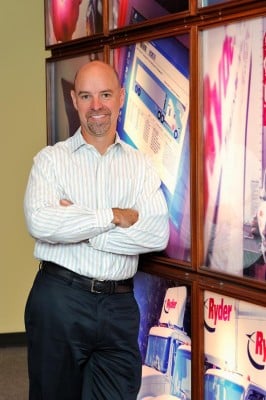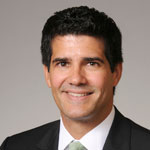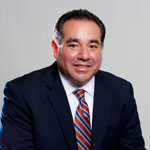Although most people know its name—Ryder System, Inc.—few know its business. President and CEO Robert Sanchez intends to change that
When he became president and CEO of Ryder System, Inc. on Jan. 1, 2013, Robert Sanchez recalled his first job at a Carvel Ice Cream store in Miami, where he grew up. He was 14 years old, and his boss had an entrepreneurial epiphany so grand that he still remembers it more than 30 years later.
“Carvel is a chain of ice cream stores known for its soft-serve ice cream. We had about 20 flavors that we sold,” says Sanchez, now 47. “Miami was more diverse than most places back then, so we had a lot of customers who came into the store asking for mamey ice cream. Mamey is a tropical fruit that’s very popular in Latin America and the Caribbean, and Carvel was headquartered in Yonkers, New York. So, as you can imagine, mamey was not one of the 20 flavors it carried.”
Initially, the franchise owner instructed his employees to offer strawberry to mamey-starved customers. Unfortunately, its color—red—is the only thing strawberry has in common with mamey. Most customers, therefore, took their business to the Cuban restaurant across the parking lot.
“The owner eventually figured out that he needed to find a way to make mamey ice cream, even though Carvel didn’t offer it,” Sanchez says. “So, he went out and bought mamey at a food distributor, and he mixed it in with Carvel ice cream. Within a week it had become the store’s highest-selling ice cream next to vanilla and chocolate. That was my first lesson in business. What it taught me was: you have to really listen to your customers, and then find a way to give them what they want.”
The lesson was as much about problem solving as customer service, and Sanchez has always been a problem solver. In that way, he takes after his father, an engineer who came to the United States with just $100 in his pocket. “My parents came from Cuba by way of Spain in 1962,” says Sanchez, one of three siblings. “My father worked his way into the middle class and always told us we could achieve anything we wanted.”

Like his father, Sanchez decided to become an engineer. Upon graduating from the University of Miami, he worked as a controls engineer for aerospace manufacturer Pratt & Whitney, then as an applications engineer for Florida Power & Light Company, where his father worked for more than 20 years. Concurrently, he started a software-writing business with three college friends, which inspired in him a new interest: business.
“[In running this company] I realized there were a lot of things about the business world that I really didn’t understand,” Sanchez says. “I knew the technical side, but I didn’t have a competency in the business side. So, I decided to get an MBA.”
Sanchez left his job, sold his portion of the software business, and moved north to Philadelphia, where he received his MBA from the University of Pennsylvania’s prestigious Wharton School.
“My life changed dramatically in those two years,” recalls Sanchez, who met his wife in Miami shortly before he left for graduate school. “We had a long-distance relationship for a few months and ultimately decided to get married between my first and second year of graduate school.”
That’s how Sanchez ended up at Ryder System, Inc. “My wife had never lived north of Fort Lauderdale, so as you might imagine, winter in Philadelphia was a bit of a shock,” he says. “I was in my last year of graduate school and had a lot of job offers. One that I was really excited about was from a boutique consulting firm in Chicago. I was really excited to tell my wife about it. She listened very intently and said, ‘Listen, I love you very much and I’m really happy for you in your career. I don’t know where you’re going next, but I’m going back to Miami and I’d really like you to come with me.’ So, I looked at Ryder, which was the only company from Miami that was recruiting at Wharton that year.”
Like most people, what Sanchez knew about Ryder was limited to the color of its signature trucks: yellow. When he joined the company in 1993, however, he learned quickly that Ryder was more than moving trucks. In fact, its consumer truck rental business—which it sold in 1996, along with its yellow trucks—at that time made up just 10 percent of the company. The other 90 percent consisted of a breadbasket of various transportation and logistics services, including a robust commercial fleet management business and a thriving commercial truck leasing operation.
“Most of Ryder, I learned, works undercover,” says Sanchez, who leads more than 27,000 employees nationwide. “There are so many products that Ryder touches. The razor you use in the morning to shave was probably distributed and transported through our distribution network. The cereal you had in the morning was likely packaged and moved at some point by Ryder. The food at your local quick-service restaurant was likely delivered to the store in a Ryder-leased or -maintained truck. The parts used to build the car that you drove to work were scheduled, coordinated, and delivered to an assembly plant by Ryder. Even your local pharmacy: we deliver products to many drug stores across the country, and it’s usually a Ryder employee wearing the store’s uniform and driving a truck that says the store’s name—although it’s all owned and run by Ryder.”
Although his desire to stay married is what attracted him to Ryder, its massive size and diverse business lines is what’s kept Sanchez there for the past 20 years. “I’ve done everything in this company from writing software to dealing with investors to running businesses,” says Sanchez, who has held numerous positions at Ryder, including chief financial officer, chief information officer, and, most recently, president and chief operating officer.
Now that he’s president and CEO, Sanchez craves mamey. “When it comes to truck maintenance, logistics, and supply-chain management, we’re really good at what we do. The next chapter is going to be about growth and finding new ways to solve customer problems,” he says. “It’s really about making mamey ice cream here at Ryder. We have a few flavors we’ve been selling for a long time, but it’s time to provide our services in a different way.”
One flavor Sanchez is considering, for example, is maintenance: Ryder maintains tens of thousands of company-owned trucks that it rents and leases to customers; in the future, Sanchez says, the company could use its expertise to likewise service customer-owned trucks. Meanwhile, on the logistics side of its business, Ryder regularly coordinates just-in-time inventory delivery for auto manufacturing, a competency it could easily apply to other industries.
“I feel really good about our ability to grow by expanding the services we have,” says Sanchez, who also plans to take advantage of transportation industry trends, such as new government regulations requiring cleaner commercial engines, which makes owning and maintaining trucks more expensive for companies—which, as a result, are more likely to use third-party transportation vendors like Ryder.
His many goals will no doubt keep Sanchez busy during his tenure as Ryder’s chief executive. Still, he plans to continue making extracurricular contributions to the Hispanic community, as he has for many years, as chair of the Association of Cuban Engineers’ (ACE) Scholarship Foundation, of which his father was a founding member.
To ACE scholarship recipients and other young people—including teens of all races who he mentors as part of the Big Brothers Big Sisters School to Work Program—Sanchez gives four pieces of advice: “First, you have to be competent. You have to learn skills. That’s why you go to school. Second, you have to treat everyone with respect. Not just your boss, but also your peers and subordinates. If you do that, you’ll find that people want to work with you. That is a very important attribute to have in leadership. Third, you have to be yourself. People really appreciate authenticity. Last, as you get into big leadership roles you have to be a big leader, which means you can’t just be a leader for Hispanics or for people like you; you have to lead everyone.”
Check out all of Hispanic Executive‘s 2013 Top 10 Líderes here.

